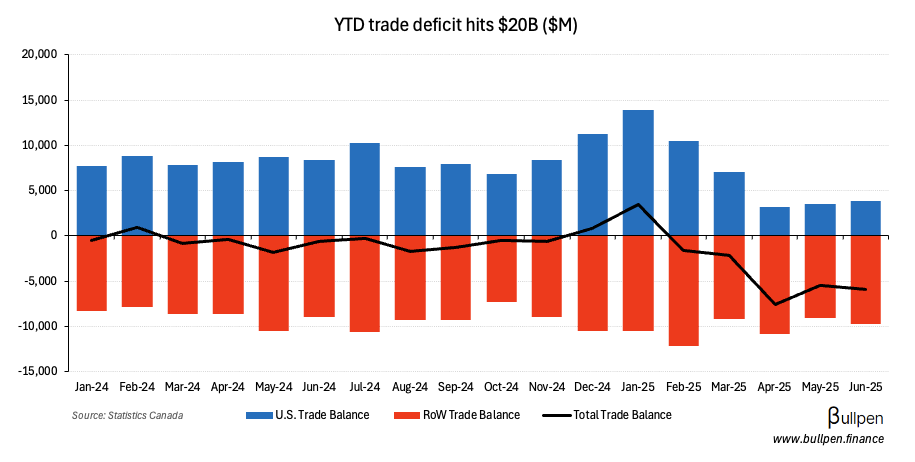Deconstructing the affordable housing value chain
As we wrote about in our first political platform comparison, increasing the supply of affordable housing is arguably priority number one for the next man up.

Any material progress towards this goal is likely to send positive reverberations across the entire affordable housing value chain, which we outline below.
Build new & retrofit old: we need both
While the focus has been on jumpstarting new construction for good reason…

… retrofitting old units is just as important, with nearly 50% of Canada’s affordable housing stock built prior to 1980.

While this should drive lumber demand, additional tariffs coming soon has us hesitant on names like Interfor (IFP), West Fraser (WFG) and Canfor (CFP) in the near-term.

Richelieu should see stronger demand tailwinds from both new builds and upgrades though, as a leading Canadian supplier of hardware products and furnishings.

Building: modular is more exciting
In our view, the potential for more affordable housing is a small negative to the REITs, who have had to contend with less immigration-linked demand recently.

With occupancy seeing some pressure, it’s possible that a wave of new supply could push it lower. More supply could also cap the ability for rent increases in the more premium segments of the market where names like Minto (MI-UN) operate.

What does look interesting in the affordability discussion are the modular builders, and a number of Canadian firms have been investing here over the past decade.
Company | Deal | Year |
|---|---|---|
ATCO (ACO-X) | NRB Modular Solutions acquisition | 2024 |
ATCO (ACO-X) | Triple M Housing acquisition | 2023 |
Brookfield Business Partners (BBU-U) | Modulaire Group acquisition | 2021 |
Bird Construction (BDT) | 50% Stack Modular investment | 2017 |
Given BBU’s Modulaire business operates outside of North America, and BDT’s investment in Stack Modular is small relative to its total book of business, ATCO’s structures and logistics business (>20% of earnings) feels like the most interesting way to play.

Management is confident in its market position in Canada…
With this acquisition, ATCO Structures is now the only national modular company that provides multiple forms of advanced new modular products, fleet diverse manufacturing capability, and world-class site construction and project management capabilities across all of Canada.
… has a strong outlook for the business line…
We expect the current backlog of opportunities in front of us to continue throughout 2025 as an imbalance between housing demand and supply persists.
… and the stock trades at a discount to its historical average. Could be interesting!

Financing: smaller lenders to benefit
While the Big-6 banks will surely be involved on the lending side of a surge in affordable housing, we’re skipping over them here as it’s unlikely to be material to their multi-trillion dollar balance sheets.
With multi-unit in focus, Timbercreek Financial (TF) could see origination tailwinds in the largest segment of its mortgage portfolio.

EQB Inc. (EQB) should also benefit on the mortgage front, though more on the single-family B2C business, which accounts for over half of its earning asset base.

First National (FN) should benefit too, as the leading non-bank mortgage lender in the country. It relies on loan volume for growth, given it typically packages up the loans for sale to larger institutions for a fee.

Lastly, goeasy Ltd. (GSY) could see additional demand for its home equity credit (easyfinancial) and lease-to-own products (easyhome) as more non-prime borrowers step into the real estate market.

Downstream: insurers, appraisers, infra
More homes should drive more home insurance policies, and given the focus on affordability we’d expect mass market insurers like Intact Financial (IFC)…

… and digital-first insurers like Definity Financial (DFY) to benefit.

More homes should also drive appraisal activity, benefitting Real Matters (REAL), a Canadian tech company whose marketplace delivers a more efficient appraisal process.

Lastly, a boom in housing means new communities, and new residential communities need infrastructure. Stella-Jones (SJ) is an interesting way to play that despite only ~30% of revenue coming from Canada - it could see increased demand for both utility poles and residential lumber.

Get smarter on Canadian markets
Get our insight-packed coverage of Canadian markets delivered to your inbox 3x per week in 5 minutes or less.
Get smarter on Canadian markets
Get The Morning Meeting, our insight-packed Canadian markets newsletter delivered to your inbox 3x per week in 5 minutes or less.
Read by 1,000+ professionals from:

